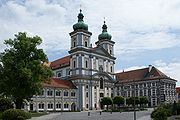
Waldsassen Abbey
Encyclopedia
Waldsassen Abbey is a Cistercian nunnery, formerly a Cistercian monastery, located on the River Wondreb at Waldsassen
near Tirschenreuth
, Oberpfalz in Bavaria
, Germany
, close to the border with the Czech Republic
.
monk of Sigeberg Abbey, with the permission of his former abbot Kuno, then Bishop of Regensburg, and built between 1128 and 1132. The original community was sent to Waldsassen from Volkenroda Abbey
in Thuringia
, of the line of Morimond Abbey
. The first abbot was elected in 1133.

 Soon the abbey became one of the most renowned and powerful of the times. As the number of monks increased, several important foundations were made at Sedlitz and Ossegg in Bohemia
Soon the abbey became one of the most renowned and powerful of the times. As the number of monks increased, several important foundations were made at Sedlitz and Ossegg in Bohemia
, at Walderbach
, near Regensburg, and in other places. In 1147, Conrad III
, King of Germany, granted it reichsunmittelbar status, making it an Imperial abbey. Several of its thirty-seven abbots up to the Reformation were illustrious for sanctity and learning; of them, Herman, the seventh abbot, and John, the seventeenth, as well as Gerwich, its founder, and Wigand, the first prior, are commemorated in the menology.
From the middle of the fourteenth century, Waldsassen alternated between periods of prosperity and decadence. Wars, famines, excessive taxation, and persecution by the Hussites made it suffer much. During the Bavarian War (1504) the monastery, church and farm-buildings were burned, but immediately afterwards rebuilt, and the new church was consecrated in 1517.
In 1525, during the German Peasants' War
, part of the buildings were again destroyed, and were beautifully restored by Georg III (1531–37), the last of the first series of abbots.
From 1537 to 1560 in the course of the Reformation
administrators were appointed by the civil authorities: Frederick III, Elector Palatine
, named his brother Richard for this office. The monks were then forced to apostatize or flee, or were put to death. As a result, in 1543, the abbey lost its imperial immediacy to the Electoral Palatinate. For about a hundred years it remained in this condition, during which time it was almost totally burned down in the Thirty Years' War
.
After the Peace of Westphalia
Roman Catholicism was restored in Bavaria. In 1669, Waldsassen was restored to the Cistercians, and in 1690 Albrecht, first of the second series of abbots (who were six in number), was elected, regaining control of the abbey, but not its Reichsfreiheit. The buildings were sumptuously rebuilt, and the number of religious again became considerable. The abbey became well known for its hospitality, particularly during the famines of 1702–03 and 1772–73, and during the French Revolution
. Under Abbot Athanasius (1793–1803) science and learning were highly cultivated.
When the monastery was dissolved and secularised
under the Reichsdeputationshauptschluss of 1803 it had over eighty members, who were dispersed with State pensions from Electoral Bavaria
.
of Seligenthal, who in the following year took possession, established monastic enclosure, and opened an institute for the education of girls. At first a priory, the nunnery was raised to the status of an abbey in 1925.
The church was declared a basilica minor in 1969.
The spectacular Baroque
library is particularly noteworthy. Part of the former monastic premises now accommodates an International Ceramics Museum.
Waldsassen
Waldsassen is a town in the district of Tirschenreuth bordering the Czech Republic in the Upper Palatinate, Bavaria.As of June 2005, Waldsassen had a population of 7,483....
near Tirschenreuth
Tirschenreuth
Tirschenreuth is the capital city of the district of Tirschenreuth. It is located in the northeast of Bavaria, very close to the Czech-Bavarian border.-Geography:...
, Oberpfalz in Bavaria
Bavaria
Bavaria, formally the Free State of Bavaria is a state of Germany, located in the southeast of Germany. With an area of , it is the largest state by area, forming almost 20% of the total land area of Germany...
, Germany
Germany
Germany , officially the Federal Republic of Germany , is a federal parliamentary republic in Europe. The country consists of 16 states while the capital and largest city is Berlin. Germany covers an area of 357,021 km2 and has a largely temperate seasonal climate...
, close to the border with the Czech Republic
Czech Republic
The Czech Republic is a landlocked country in Central Europe. The country is bordered by Poland to the northeast, Slovakia to the east, Austria to the south, and Germany to the west and northwest....
.
First foundation
The monastery, the first Cistercian foundation in Bavaria, was founded by Gerwich of Wolmundstein, a BenedictineBenedictine
Benedictine refers to the spirituality and consecrated life in accordance with the Rule of St Benedict, written by Benedict of Nursia in the sixth century for the cenobitic communities he founded in central Italy. The most notable of these is Monte Cassino, the first monastery founded by Benedict...
monk of Sigeberg Abbey, with the permission of his former abbot Kuno, then Bishop of Regensburg, and built between 1128 and 1132. The original community was sent to Waldsassen from Volkenroda Abbey
Volkenroda Abbey
Volkenroda Abbey is a former Cistercian monastery in the municipality of Körner in the Unstrut-Hainich district of Thuringia, Germany.-History:...
in Thuringia
Thuringia
The Free State of Thuringia is a state of Germany, located in the central part of the country.It has an area of and 2.29 million inhabitants, making it the sixth smallest by area and the fifth smallest by population of Germany's sixteen states....
, of the line of Morimond Abbey
Morimond Abbey
Morimond Abbeyis a religious complex in Parnoy-en-Bassigny, Haute-Marne department, in the Champagne-Ardenne region of France. It was the fourth of the four great daughter abbeys of Cîteaux Abbey, of primary importance in the spread of the Cistercian Order, along with La Ferté to the south,...
. The first abbot was elected in 1133.


Bohemia
Bohemia is a historical region in central Europe, occupying the western two-thirds of the traditional Czech Lands. It is located in the contemporary Czech Republic with its capital in Prague...
, at Walderbach
Walderbach
Walderbach is a municipality in the district of Cham in Bavaria in Germany....
, near Regensburg, and in other places. In 1147, Conrad III
Conrad III of Germany
Conrad III was the first King of Germany of the Hohenstaufen dynasty. He was the son of Frederick I, Duke of Swabia, and Agnes, a daughter of the Salian Emperor Henry IV.-Life and reign:...
, King of Germany, granted it reichsunmittelbar status, making it an Imperial abbey. Several of its thirty-seven abbots up to the Reformation were illustrious for sanctity and learning; of them, Herman, the seventh abbot, and John, the seventeenth, as well as Gerwich, its founder, and Wigand, the first prior, are commemorated in the menology.
From the middle of the fourteenth century, Waldsassen alternated between periods of prosperity and decadence. Wars, famines, excessive taxation, and persecution by the Hussites made it suffer much. During the Bavarian War (1504) the monastery, church and farm-buildings were burned, but immediately afterwards rebuilt, and the new church was consecrated in 1517.
In 1525, during the German Peasants' War
German Peasants' War
The German Peasants' War or Great Peasants' Revolt was a widespread popular revolt in the German-speaking areas of Central Europe, 1524–1526. At its height in the spring and summer of 1525, the conflict involved an estimated 300,000 peasants: contemporary estimates put the dead at 100,000...
, part of the buildings were again destroyed, and were beautifully restored by Georg III (1531–37), the last of the first series of abbots.
From 1537 to 1560 in the course of the Reformation
Protestant Reformation
The Protestant Reformation was a 16th-century split within Western Christianity initiated by Martin Luther, John Calvin and other early Protestants. The efforts of the self-described "reformers", who objected to the doctrines, rituals and ecclesiastical structure of the Roman Catholic Church, led...
administrators were appointed by the civil authorities: Frederick III, Elector Palatine
Frederick III, Elector Palatine
Frederick III of Simmern, the Pious, Elector Palatine of the Rhine was a ruler from the house of Wittelsbach, branch Palatinate-Simmern-Sponheim. He was a son of John II of Simmern and inherited the Palatinate from the childless Elector Otto-Henry, Elector Palatine in 1559...
, named his brother Richard for this office. The monks were then forced to apostatize or flee, or were put to death. As a result, in 1543, the abbey lost its imperial immediacy to the Electoral Palatinate. For about a hundred years it remained in this condition, during which time it was almost totally burned down in the Thirty Years' War
Thirty Years' War
The Thirty Years' War was fought primarily in what is now Germany, and at various points involved most countries in Europe. It was one of the most destructive conflicts in European history....
.
After the Peace of Westphalia
Peace of Westphalia
The Peace of Westphalia was a series of peace treaties signed between May and October of 1648 in Osnabrück and Münster. These treaties ended the Thirty Years' War in the Holy Roman Empire, and the Eighty Years' War between Spain and the Dutch Republic, with Spain formally recognizing the...
Roman Catholicism was restored in Bavaria. In 1669, Waldsassen was restored to the Cistercians, and in 1690 Albrecht, first of the second series of abbots (who were six in number), was elected, regaining control of the abbey, but not its Reichsfreiheit. The buildings were sumptuously rebuilt, and the number of religious again became considerable. The abbey became well known for its hospitality, particularly during the famines of 1702–03 and 1772–73, and during the French Revolution
French Revolution
The French Revolution , sometimes distinguished as the 'Great French Revolution' , was a period of radical social and political upheaval in France and Europe. The absolute monarchy that had ruled France for centuries collapsed in three years...
. Under Abbot Athanasius (1793–1803) science and learning were highly cultivated.
When the monastery was dissolved and secularised
German Mediatisation
The German Mediatisation was the series of mediatisations and secularisations that occurred in Germany between 1795 and 1814, during the latter part of the era of the French Revolution and then the Napoleonic Era....
under the Reichsdeputationshauptschluss of 1803 it had over eighty members, who were dispersed with State pensions from Electoral Bavaria
Electorate of Bavaria
The Electorate of Bavaria was an independent hereditary electorate of the Holy Roman Empire from 1623 to 1806, when it was succeeded by the Kingdom of Bavaria....
.
Second foundation
In 1863, the remains of the old abbey were bought by the Cistercian nunsCistercian nuns
Cistercian nuns are female members of the Cistercian Order, a religious order belonging to the Roman Catholic branch of the Catholic Church.-History:...
of Seligenthal, who in the following year took possession, established monastic enclosure, and opened an institute for the education of girls. At first a priory, the nunnery was raised to the status of an abbey in 1925.
The church was declared a basilica minor in 1969.
The spectacular Baroque
Baroque
The Baroque is a period and the style that used exaggerated motion and clear, easily interpreted detail to produce drama, tension, exuberance, and grandeur in sculpture, painting, literature, dance, and music...
library is particularly noteworthy. Part of the former monastic premises now accommodates an International Ceramics Museum.

